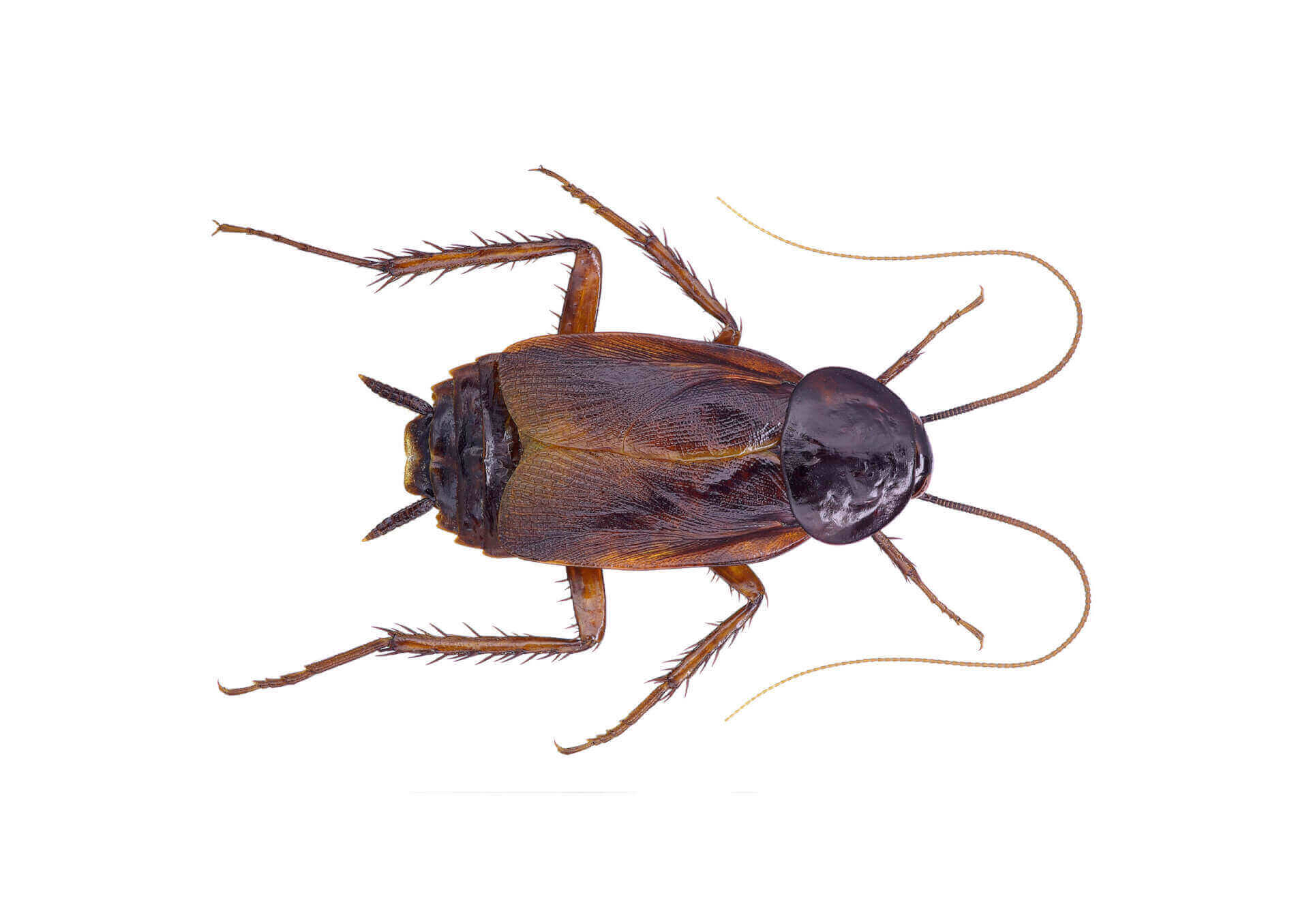Oriental Cockroach Facts & Information
Everything you need to know about the Oriental cockroach
What Do Oriental Cockroaches Look LIke

Oriental cockroaches can be either shiny black or dark reddish-brown in color. They have a “greasy” sheen. As adults, the male and female cockroaches, though both large in size, are quite different in appearance. Growing to only 1 inch in length, the smaller males have shortened, three-quarter-length wings. Female Oriental cockroaches have no wings and grow to about 1 ¼ inch. Whether they have wings or not, neither can actually fly. If you see them in your home or business, a cockroach exterminator is necessary.
There are three telltale signs of an oriental cockroach infestation: sightings, egg capsules, and odor. Especially during the warmer months of the year, oriental cockroaches may be seen outside near moist gutters, around landscaping beds, and coming in and out of sewers and storm drains during the night. During the day, Oriental cockroaches congregate in dark, moist, and undisturbed spaces. Aside from sightings of the cockroaches themselves, egg cases ranging in size from 8 to 10 mm in length will appear during an infestation. Oriental cockroach egg cases are usually dark brown or reddish in color. Each egg case can hold about 16 eggs. Smells will also alert you to an Oriental cockroach infestation. Oriental cockroaches secrete chemicals to communicate with each other. The chemicals have a notorious musty odor and will have you calling a professional cockroach exterminator.Not the cockroach you have?
There are three telltale signs of an oriental cockroach infestation: sightings, egg capsules, and odor. Especially during the warmer months of the year, oriental cockroaches may be seen outside near moist gutters, around landscaping beds, and coming in and out of sewers and storm drains during the night. During the day, Oriental cockroaches congregate in dark, moist, and undisturbed spaces. Aside from sightings of the cockroaches themselves, egg cases ranging in size from 8 to 10 mm in length will appear during an infestation. Oriental cockroach egg cases are usually dark brown or reddish in color. Each egg case can hold about 16 eggs. Smells will also alert you to an Oriental cockroach infestation. Oriental cockroaches secrete chemicals to communicate with each other. The chemicals have a notorious musty odor and will have you calling a professional cockroach exterminator.Not the cockroach you have?
How Did I Get Oriental Cockroaches
Primarily an outdoor species, oriental cockroaches are often found in sewers and under debris, leaves, stones and firewood. Additionally, these pests can also live in the voids or openings beneath porches. While their natural habitat is outdoors, oriental cockroaches tend to invade homes during the summer. They will enter structures through door thresholds, under sliding glass doors, along utility pipes, and through floor drains. Once indoors, oriental cockroaches find harborage in basements and crawl spaces, as they prefer damp, cool locations. Furthermore, these cockroaches will usually crawl around toilets, sinks, pipes, and service ducts. They can flatten down significantly so keeping them out requires you to have zero cracks or crevices in your home. Tough to accomplish but we can help with that exclusion work.
The oriental cockroach feeds on all kinds of food, especially decaying organic matter, starchy foods, and garbage. Though these cockroaches have been noted to survive for up to a month without food, they can’t live for more than two weeks without water so, they tend to gather in large numbers near water sources. Excess moisture in your home can be an attractant to these cockroaches.
The oriental cockroach feeds on all kinds of food, especially decaying organic matter, starchy foods, and garbage. Though these cockroaches have been noted to survive for up to a month without food, they can’t live for more than two weeks without water so, they tend to gather in large numbers near water sources. Excess moisture in your home can be an attractant to these cockroaches.
What Problems Do Oriental Cockroaches Cause
Often called “water bugs,” they eat various types of organic matter but prefer starch (e.g., book glue, decaying vegetable matter, grain products). All cockroaches are filthy. Oriental cockroaches can cause additional problems, though. They transmit bacteria such as E. coli and salmonella, taint food with pathogens, and excrete foul odors. Their waste products can be problematic for people with allergies and asthma. Call us in for the proper cockroach treatments for ultimate roach control. Disease-producing organisms such as bacteria, protozoa, and viruses have been found in their bodies.
Different forms of gastroenteritis (food poisoning, dysentery, diarrhea, etc.) are the principal diseases transmitted by Oriental cockroaches. The insects carry these disease-causing organisms on their legs and bodies and deposit the organisms on food and utensils as they forage. Cockroach excrement and cast skins also contain a number of allergens, to which many people exhibit allergic responses such as skin rashes, watery eyes, congestion of nasal passages, asthma, and sneezing.
Different forms of gastroenteritis (food poisoning, dysentery, diarrhea, etc.) are the principal diseases transmitted by Oriental cockroaches. The insects carry these disease-causing organisms on their legs and bodies and deposit the organisms on food and utensils as they forage. Cockroach excrement and cast skins also contain a number of allergens, to which many people exhibit allergic responses such as skin rashes, watery eyes, congestion of nasal passages, asthma, and sneezing.
How Can I Prevent Oriental Cockroaches
The best advice for Oriental cockroach control is to practice good sanitation. To prevent oriental cockroaches from infesting a home, vacuum often and keep a spotless kitchen. Consider using a dehumidifier to prevent moisture buildup or having a moisture barrier installed in your home. On the exterior of the home, seal all possible entry points with a silicone-based caulk, paying close attention to cracks around doors, windows, pipes, and utility lines. Additionally, fortify all entrances around utility pipes and ventilate crawl spaces to prevent moisture buildup. Since oriental cockroaches are very dependent on water, eliminate sources of standing water and divert water away from the home’s foundation with properly functioning downspouts, gutters, and splash blocks.
Why Waltham for Oriental Cockroach Control
We’re passionate about keeping Oriental cockroaches out of your home or business because we live and work here – it’s our neighborhood, too. With our 130 years of experience keeping homes and businesses in Massachusetts, Connecticut, New York, Maine, Vermont, New Hampshire, and Rhode Island safe from pests, Waltham has the experience you can trust.
Satisfaction Guarantee
24-Hour Guaranteed Response
Board Certified Entomologists
Need help with Oriental cockroaches?
GET MY QUOTE
“Exceptional service. Prompt and professional. Used for both business and home. Very efficient and honest.”
Agawan, MA
